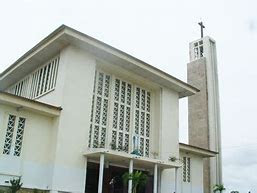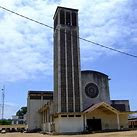Central Africa
This blog will discuss the Catholic Church in the Central African Republic, Chad, Equatorial Guinea, Gabon, and the Republic of the Congo (Brazzaville). All of these nations except for Equatorial Guinea were eventually organized by the French into French Equatorial Africa starting in 1908. The colonial capital was established in Brazzaville.
Central African Republic
In a continent that has a sad history of colonial exploitation, the Central African Republic has a worse history than most. The slave trade was very active in the 16th and 17th Centuries. In the late 1800s, the French, Germans, and Belgians, competed for colonies in this part of Africa, with the French gaining control of what is now the Central African Republic. The colony became part of French Equatorial Africa in 1920. The French exploited natural resources and forced the local people to work essentially as slaves. By 1940, the population had declined by half. France granted independence in 1960. Catholic missionary activity started in 1909 and the French invited Protestant missionaries in the 1920s and 1930s.
Over 80 percent of the Central African Republic’s 5.4 million people are Christian—about 50 percent Protestant and 30 percent Catholic. Another 10 percent are Muslim. Many people mix local folk religions with either Christianity or Islam. There is one Catholic ecclesiastic province—Bangui. Maronite-rite Catholics are under the jurisdiction of the Diocese of the Annunciation in Ibadan, Nigeria.
Province of Bangui
The province consists of the entire nation. The Metropolitan Archdiocese of Bangui began as an apostolic prefecture in 1909, became an apostolic vicariate in 1937, and a metropolitan archdiocese in 1955.
The Cathedral of Our Lady of the Immaculate Conception is in Bangui. The red-brick cathedral was built in the 1930s and has twin towers on either side of the façade. The Cathedral was attacked in 2013 and 2014 by rebel forces, but was visited by Pope Francis in 2015.
The Province has eight suffragan dioceses.
- The Diocese of Berberati was established as an apostolic prefecture in 1940, became an apostolic vicariate in 1952, and a diocese in 1955.
- The Diocese of Bossangoa was established as an apostolic prefecture in 1959 and became a diocese in 1964.
- The Diocese of Bangassou was established as an apostolic prefecture in 1954 and became a diocese in 1964.
- The Diocese of Bambari was established in 1965.
- The Diocese of Bouar was established in 1978.
- The Diocese of Mbaiki was established in 1995.
- The Diocese of Kaga-Bandoro was established in 1997.
- The Diocese of Alindao was established in 2004.
Chad
Chad was part of several African empires starting in the 8th Century, but became part of French Equatorial Africa in 1920. Chad gained its independence in 1960. Catholic evangelization started in 1929 with the arrival of the Holy Ghost Fathers, but Protestants had already begun evangelization by that time.
Slightly more than half of Chad’s 17.4 million people are Muslim. Protestants account for 24 percent and Catholics for 20 percent. There is one Catholic ecclesiastic province—N’Djamena. In addition, the Apostolic Vicariate of Mongo serves about 6,000 Catholics and is immediately subject to the Pope. It was established as an apostolic prefecture in 2001 and became an apostolic vicariate in 2009. The Vicariate covers most of eastern Chad—an area of over 200,000 square miles. Maronite-rite Catholics are under the jurisdiction of the Diocese of the Annunciation in Ibadan, Nigeria.
Province of N’Djamena
The province consists of most of the nation. The Apostolic Prefecture of Fort-Lamy was established in 1947. This became a diocese in 1955 and a metropolitan archdiocese in 1961. It became the Metropolitan Archdiocese of N’Djamena in 1973.
Our Lady of Peace Cathedral in N’Djamena was built in 1965, but destroyed in 1980 during a civil war. An arch is all that is left from the old cathedral. The Cathedral was rebuilt in a French Colonial style between 1983 and 1986.
The Province has six suffragan dioceses.
- The Diocese of Moundou was established as an apostolic prefecture in 1951 and became a diocese in 1959.
- The Diocese of Pala was established as an apostolic prefecture in 1956 and became a diocese in 1964.
- The Diocese of Sarh was established as an apostolic prefecture in 1961 and was promoted to a diocese in 1972.
- The Diocese of Doba was established in 1989.
- The Diocese of Gore was established in 1998.
- The Diocese of Lai was established in 1998.
- The Diocese of Koumra was established in 2023.
Equatorial Guinea
Equatorial Guinea became a Spanish colony in the late 1700s and Catholic evangelization began in 1841. The nation gained its independence from Spain in 1968.
Between 80 and 90 percent of Equatorial Guinea’s 900,000 people are Catholic. There is one Catholic ecclesiastic province—Malabo. Maronite-rite Catholics are under the jurisdiction of the Diocese of the Annunciation in Ibadan, Nigeria.
Province of Malabo
The province consists of the entire nation. The Metropolitan Archdiocese of Malabo began as an apostolic prefecture in 1855, became an apostolic vicariate in 1904, a diocese in 1966, and a metropolitan archdiocese in 1982.
St. Elizabeth’s Cathedral is located in Malabo and is dedicated to St. Elizabeth of Hungary. The Neo-Gothic structure was built between 1897 and 1916 and has two 130-foot towers. It was severely damaged by fire in 2020 during a restoration.
The first two pictures are from Pinterest and the last is from Wikipedia.
The Province has four suffragan dioceses.
- The Diocese of Bata was established as an apostolic vicariate in 1965 and became a diocese in 1966.
- The Diocese of Ebebiyin was established in 1982.
- The Diocese of Evinayong was established in 2017.
- The Diocese of Mongomo was established in 2017.
Gabon
European explorers came to Gabon in the early 19th Century and France gained full control of Gabon in 1885. Gabon became part of French Equatorial Africa in 1910 and it gained its independence from France in 1960. French missionaries from the Congregation of the Holy Spirit brought the Faith to Gabon in the first half of the 19th Century although the Faith did not spread beyond the coastal cities until the 1880s.
About 42 percent of Gabon’s population of 2.3 million are Catholic. About 12 percent are traditional Protestants, 27 percent belong to quasi-Christian African denominations, and 10 percent are Muslim. There is one Catholic ecclesiastic province—Libreville. There is also the Apostolic Vicariate of Makokou which serves 28,000 Catholics in northeastern Gabon in an area that is about half Catholic. It began as an apostolic prefecture in 2003, became an apostolic vicariate in 2014, and is immediately subject to the Pope. Maronite-rite Catholics are under the jurisdiction of the Diocese of the Annunciation in Ibadan, Nigeria.
Province of Libreville
The province consists of most of the nation. The Metropolitan Archdiocese of Libreville began as the Apostolic Prefecture of the two Guineas and Senegambia in 1842. This became an apostolic vicariate in 1846 and the Diocese of Libreville in 1955. It became a metropolitan archdiocese in 1958.
The Cathedral of Our Lady of the Assumption in Libreville was built between 1958 and 1964.
The Province has four suffragan dioceses.
- The Diocese of Mouila was established in 1958.
- The Diocese of Oyem was established in 1969.
- The Diocese of Franceville was established in 1974.
- The Diocese of Port-Gentil was established in 2003.
Republic of the Congo—Brazzaville
The territory that is now the Republic of the Congo came under the control of France in 1880 and became part of French Equatorial Africa in 1908. It gained its independence from France in 1960. Serious evangelization began in the 1880s.
One third (and possibly as many as a half) of the Republic of the Congo’s 5.4 million people are Catholic. Almost 20 percent are traditional Protestants and 22 percent belong to African Christian or quasi-Christian churches. There are three Catholic ecclesiastic provinces—Brazzaville, Owando, and Pointe-Noire. Maronite-rite Catholics are under the jurisdiction of the Diocese of the Annunciation in Ibadan, Nigeria.
Province of Brazzaville
The province consists of the civil provinces of Brazzaville, Pool, and Plateaux in the southeastern portion of the Republic. The Metropolitan Archdiocese of Brazzaville began as an apostolic vicariate in 1886 and was promoted to a metropolitan archdiocese in 1955.
Sacred Heart Cathedral in Brazzaville was built in 1892 and has been renovated twice. The main entrance has statues of Saints Peter and Paul that are over 100 years old.
The first picture is from a local blog, the second is from Panaramio, and the last from TripAdvisor.
The Province has two suffragan dioceses.
- The Diocese of Kinkala was established in 1987.
- The Diocese of Gamboma was established in 2013.
Province of Owando
The province consists of the civil provinces of Cuvette, Cuvette-Ouest, Likouala, and Sangha, in the northern part of the Republic. The Metropolitan Archdiocese of Owando was established as an apostolic vicariate in 1950, became a diocese in 1955, and a metropolitan archdiocese in 2020.
The Cathedral of Christ the King in Owando was completed in 1959. It was enlarged and a bell tower was added in 1975.
From Facebook
The Province has two suffragan dioceses.
- The Diocese of Ouesso was established in 1983.
- The Diocese of Impfondo was established as an apostolic prefecture in 2000 and became a diocese in 2011.
Province of Pointe-Noire
The province consists of the civil provinces of Bouenza, Kouilou, Kekoumou, Niari, and Pointe-Noire, in the southwestern portion of the Republic. The Apostolic Vicariate of Lower French Congo was established in 1890, became the Diocese of Pointe-Noire in 1955, and the Metropolitan Archdiocese of Pointe-Noire in 2020.
The Cathedral of St. Peter the Apostle is in Pointe-Noire and was built prior to 1975.
The Province has two suffragan dioceses.
- The Diocese of Nkayi was established in 1983.
- The Diocese of Dolisie was established in 2013.
Definitions
The Catholic Church is mostly divided into ecclesiastical provinces—a province consists of a metropolitan archdiocese and one or more dioceses. The province and the archdiocese are led by an archbishop. Each of the dioceses is called a suffragan diocese and is led by a bishop. Archbishops have some responsibilities for the province, but all bishops answer directly to the Pope. There are also missionary jurisdictions below the level of a diocese, including apostolic prefectures and apostolic vicariates.
Most Catholics in the world belong to the Latin or Roman rite. Rite refers to liturgical practices, ecclesiastical discipline, and spiritual heritage. Many Catholics belong to one of two dozen Eastern rite churches. Eastern rite churches trace their heritage to Eastern Europe and the Middle East.















No comments:
Post a Comment